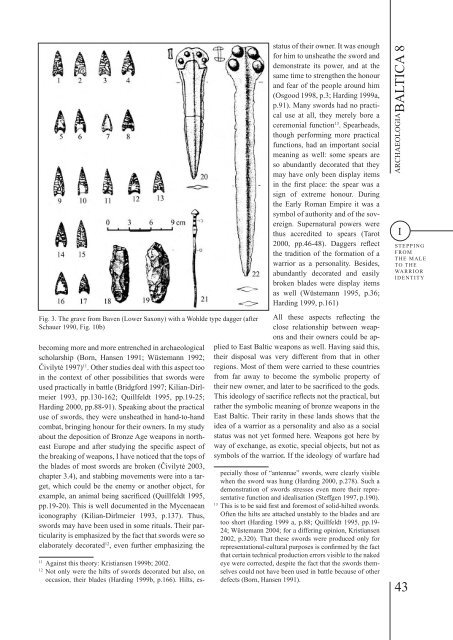BALTICA8 - Klaipėdos universitetas
BALTICA8 - Klaipėdos universitetas
BALTICA8 - Klaipėdos universitetas
- TAGS
- universitetas
- www.ku.lt
You also want an ePaper? Increase the reach of your titles
YUMPU automatically turns print PDFs into web optimized ePapers that Google loves.
Fig. 3. The grave from Baven (Lower Saxony) with a Wohlde type dagger (after<br />
Schauer 990, Fig. 0b)<br />
becoming more and more entrenched in archaeological<br />
scholarship (Born, Hansen 1991; Wüstemann 1992;<br />
Čivilytė 1997) . Other studies deal with this aspect too<br />
in the context of other possibilities that swords were<br />
used practically in battle (Bridgford 997; Kilian-Dirlmeier<br />
993, pp. 30- ; Quillfeldt 995, pp. 9- 5;<br />
Harding 000, pp.88-9 ). Speaking about the practical<br />
use of swords, they were unsheathed in hand-to-hand<br />
combat, bringing honour for their owners. In my study<br />
about the deposition of Bronze Age weapons in northeast<br />
Europe and after studying the specific aspect of<br />
the breaking of weapons, I have noticed that the tops of<br />
the blades of most swords are broken (Čivilytė 2003,<br />
chapter 3.4), and stabbing movements were into a target,<br />
which could be the enemy or another object, for<br />
example, an animal being sacrificed (Quillfeldt 1995,<br />
pp. 9- 0). This is well documented in the Mycenaean<br />
iconography (Kilian-Dirlmeier 993, p. 37). Thus,<br />
swords may have been used in some rituals. Their particularity<br />
is emphasized by the fact that swords were so<br />
elaborately decorated , even further emphasizing the<br />
Against this theory: Kristiansen 999b; 00 .<br />
Not only were the hilts of swords decorated but also, on<br />
occasion, their blades (Harding 999b, p. ). Hilts, es-<br />
status of their owner. It was enough<br />
for him to unsheathe the sword and<br />
demonstrate its power, and at the<br />
same time to strengthen the honour<br />
and fear of the people around him<br />
(Osgood 998, p.3; Harding 999a,<br />
p.9 ). Many swords had no practical<br />
use at all, they merely bore a<br />
ceremonial function 3 . Spearheads,<br />
though performing more practical<br />
functions, had an important social<br />
meaning as well: some spears are<br />
so abundantly decorated that they<br />
may have only been display items<br />
in the first place: the spear was a<br />
sign of extreme honour. During<br />
the Early Roman Empire it was a<br />
symbol of authority and of the sovereign.<br />
Supernatural powers were<br />
thus accredited to spears (Tarot<br />
2000, pp.46-48). Daggers reflect<br />
the tradition of the formation of a<br />
warrior as a personality. Besides,<br />
abundantly decorated and easily<br />
broken blades were display items<br />
as well (Wüstemann 1995, p.36;<br />
Harding 999, p. )<br />
All these aspects reflecting the<br />
close relationship between weapons<br />
and their owners could be applied<br />
to East Baltic weapons as well. Having said this,<br />
their disposal was very different from that in other<br />
regions. Most of them were carried to these countries<br />
from far away to become the symbolic property of<br />
their new owner, and later to be sacrificed to the gods.<br />
This ideology of sacrifice reflects not the practical, but<br />
rather the symbolic meaning of bronze weapons in the<br />
East Baltic. Their rarity in these lands shows that the<br />
idea of a warrior as a personality and also as a social<br />
status was not yet formed here. Weapons got here by<br />
way of exchange, as exotic, special objects, but not as<br />
symbols of the warrior. If the ideology of warfare had<br />
pecially those of “antennae” swords, were clearly visible<br />
when the sword was hung (Harding 000, p. 78). Such a<br />
demonstration of swords stresses even more their representative<br />
function and idealisation (Steffgen 997, p. 90).<br />
3 This is to be said first and foremost of solid-hilted swords.<br />
Often the hilts are attached unstably to the blades and are<br />
too short (Harding 999 a, p.88; Quillfeldt 995, pp. 9-<br />
24; Wüstemann 2004; for a differing opinion, Kristiansen<br />
00 , p.3 0). That these swords were produced only for<br />
representational-cultural purposes is confirmed by the fact<br />
that certain technical production errors visible to the naked<br />
eye were corrected, despite the fact that the swords themselves<br />
could not have been used in battle because of other<br />
defects (Born, Hansen 99 ).<br />
ARCHAEOLOGIA BALTICA 8<br />
I<br />
STEPPING<br />
FROM<br />
THE MALE<br />
TO THE<br />
WARRIOR<br />
IDENTITY<br />
43

















